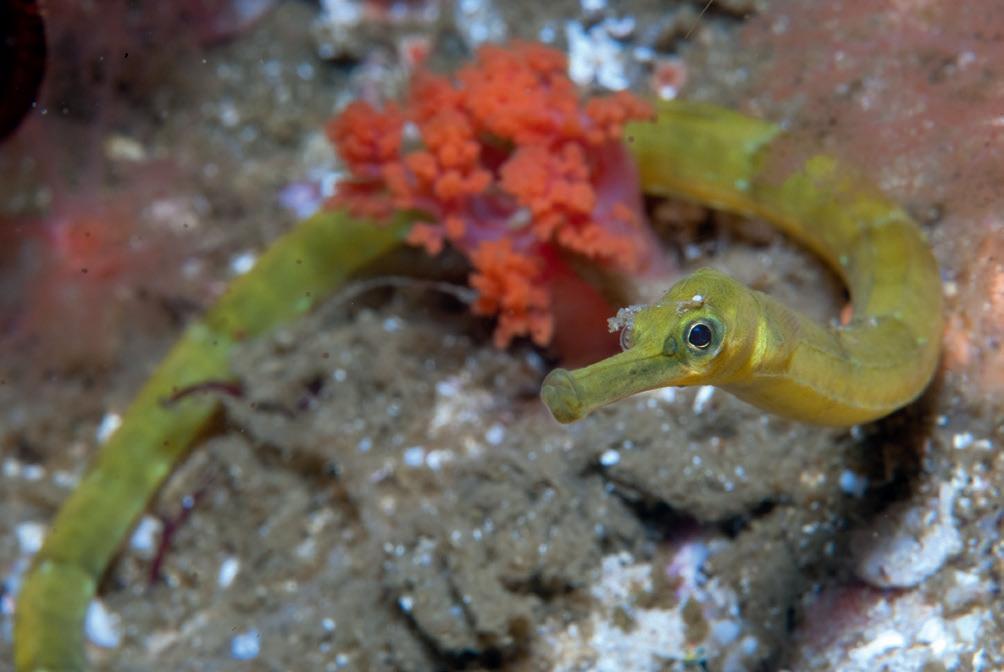
4 minute read
COLOURFUL LITTLE CHARACTERS Discover more about the secret – and unconventional – lives of seahorses
Naturalist Georgina Jones takes us on a fascinating journey into the secret life of seahorses. We discover an unconventional sea family indeed.

COLOURFUL
little characters
IF ASKED TO DRAW a fish, most people would come up with a sleek, streamlined shape with a pointed nose and a split tail. Not an animal that could have been made up of a menagerie of other animals, which is what seahorses resemble. Seahorses have heads like horses – if horses wore crowns. Their eyes, like those of a chameleon, focus independently. Their laughably miniature fins are more like insect wings than anything else. They lack scales, having skin stretched over a boxlike armour plating, their bellies are cartoonishly round, and their tails
are snaky and prehensile. Seahorses are clearly not evolved for high-speed chases. But they are most certainly fish, even though many evolutionary steps were probably involved in their digression from the standard fish shape and lifestyle.
Seahorses, pygmy seahorses, pipefishes and ghost pipefishes are members of an unusual fish family, the Syngnathidae. Pipefishes look like straight, skinny seahorses. Ghost pipefishes are well camouflaged to resemble seaweed or the sea fans they prefer, whereas pygmy seahorses are so tiny and so well camouflaged that their existence was only discovered through a chance collection of the sea fans on which they live.
They use their snouts to hoover up small crustaceans: by creating a vacuum along the length of their snouts, they pull small animals towards their waiting mouths. Some of the larger pipefishes also prey on other small fishes. The seahorse family has developed into becoming less fleet of fin and more stealthy. Their silly-looking fins are adapted for precision hovering. They also rely on camouflage for ambush hunting and

Left to right: When not lekking, pipefish tend to be retiring, gliding secretively through reefs and sea meadows; a seahorse looking as unfishlike as it’s possible to look, using its tail to cling onto a sea pen; pygmy seahorses are tiny and extremely well camouflaged; enigmatic ghost pipefishes overturn the seahorse family rules, the females brooding their eggs in a makeshift pouch formed by their large pectoral fins.
for escaping predators. Pygmy seahorses have the added bonus of their size: these are among the smallest known vertebrates, with the largest of them being slightly over 2cm in total length.
Yet it’s not only their shape and habits that make them different from most of the rest of the fishes. Their reproductive strategies are highly varied.
Male seahorses have an external brood pouch on their bellies into which the female inserts her ovipositor to deposit her unfertilised eggs. As the male releases sperm into the pouch to fertilise the eggs, their protective outer capsule dissolves to be replaced by a tissue produced by the male. In the course of the pregnancy, the male’s pouch supplies the developing eggs with both oxygen and nutrients, and controls the salt content of the fluids in the pouch so that, once the developed babies are ready to hatch, their pouch environment is as salty as the surrounding water.
During the male’s pregnancy, the female visits every morning and the two twine together and perform a courtship dance. This is rather less romantic than it sounds. Because seahorses don’t care for their babies once they’re born, their survival rate is very low. Consequently, seahorses must produce many babies

to ensure that at least some survive to adulthood. This means that, as soon as the female has deposited her first clutch of eggs into the male’s pouch, she must start producing the next clutch of eggs. Her daily dance with the male allows her to determine how close to birthing the babies are. And the timing is critical because at egg transfer, the eggs may make up 30% of the female’s total weight, and she has only a few hours to transfer them or be forced to dump them. The story in pygmy seahorses could well be rather different, even though these two groups are considered very closely related. Some researchers suspect that in the pygmies, the female may be the egg brooder. This is possibly because of pygmy seahorses’ extremely tiny size. As it is, the embryos found so far have been in very small numbers, typically less than a dozen per brood. In the case of pipefishes, brooding takes place either in the tail or the trunk, and always by the male. Some species have external brood pouches, with seahorsestyle authentic male pregnancies, whereas others simply paste the fertilised eggs onto their bodies to develop. These species tend to be the fastest-moving of the pipefishes, presumably to keep the developing eggs safe from predators.
Some species of pouch-brooding pipefishes demonstrate lekking, a courtship behaviour also found in birds. But unlike birds, it is the female pipefishes who display and the males who choose which female’s eggs they will accept. It is thought that this male choosiness has led to female pipefishes developing secondary sexual characteristics like larger size and brighter coloration.
The ghost pipefishes, despite their striking resemblance to pipefishes, overturn all this behaviour. In this group, the female is usually considerably larger than the male, and even though both species have relatively large pelvic fins, when breeding, the females hold their much larger pelvic fins together to make a pouch in which the fertilised eggs are brooded. As the eggs develop, they will periodically open the fin pouch to oxygenate the developing eggs.
This is clearly a fish family that makes its own rules.










